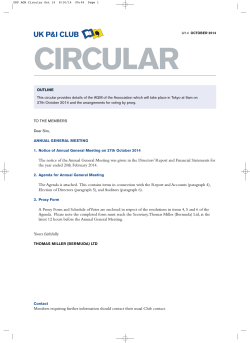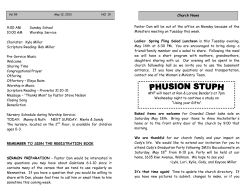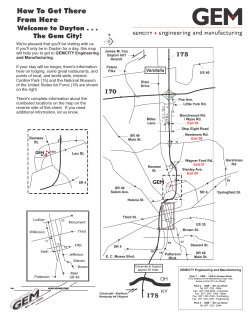
Winter 2015 Newsletter
The Adolph C. and Mary Sprague M iller I n s t it ut e Newsletter Winter 2015 for Basic Research in Science B u i l d i n g a n O rg a n i z e d O rg a n i s m Miller Fellow Focus: Amy Shyer Physical Forces as Biological Sculptors D uring animal development, naïve tissues assume a diverse array of patterns that are vital for organ function. A deeper understanding of how these patterns emerge will be needed before we can successfully regenerate wounded or worn out tissues. Can we explain the emergence of these intricate patterns in simple terms? Moreover, at what length-scale should such an explanation be couched – the molecular, cellular, or tissue level? My dissertation work suggests that relatively simple cellular dynamics coupled with tension at the tissue level may be sufficient to explain the emergence of a diverse array of patterns in the gut. As a Miller Fellow in the Department of Molecular and Cell Biology, I am continuing to ask how organs are organized, and am partially interested in whether the intriguingly simple, general mechanism that underlies the forms of the gut can be generalized to a wide range of patterns across tissues. Untangling the Loops of the Gut T he gut is a simple organ that nonetheless possesses a number of patterns needed for proper function. As the gut grows, the first challenge it faces is fitting into a cavity nearly fifty times smaller than its length. To pack into this small space, the gut coils into a series of loops as it grows. This coiling is not Inside this edition: Miller Fellow Focus 1-3 60th Anniversary Announcement 1, 5 Gifts to the Miller Institute 4 Professorship Awards 5 In the News 6 Fall Dinner in Photographs 7 Next Steps, Birth Announcements & Obituaries 8 Celebrate our - 60th Anniversary disordered like a tangled wire but is instead stereotyped – individuals within a species have the same looping pattern and each loop shares a strikingly similar radius (Figure 1A). W hat force drives the emergence of these loops? Since the cell is the fundamental unit of any tissue, an initial hypothesis supposed that subpopulations of cells within a loop divided at different rates, potentially causing some sort of curvature in the tube. But when I looked at markers of proliferation at different stages of loop formation, I found that cells divided uniformly throughout the gut tube. Puzzlingly, the heterogeneity observed at the level of the whole gut tube in the form of loops vanishes when we zoom into the loops to observe the cells that composes them. CONTINUED ON PAGE 2 > Remember those Tuesday lunch-time conversations with a colleague from another field? Or how about those amazing days and nights at the Marconi center learning about the birth of the cosmos, Noah’s flood, the origins of life, how cells communicate, or the web of interactions that provide stability to ecosystems? Don’t you wish you could go back and relive some of those moments? Well, you can. MORE ON PAGE 5 > “The pressures on a faculty member’s time are enormous and the Miller Professorship provides an extraordinary opportunity to escape these bonds and devote oneself full time to one’s research. Many of the greatest living mathematicians have visited Berkeley through the Miller programs.” - Vaughan Jones, Mathematician, Miller Professor Fall 1992, Fields Medalist, National Academy of Sciences, Distinguished Companion of The New Zealand Order of Merit, Honorary Vice President for Life of the International Guild of Knot-tyers, Miller Institute Advisory Board Member 2013 - present MillerInstitute.berkeley.edu > CONTINUED FROM PAGE 1 [Miller Fellow Focus] mize nutrient absorption by increasing luminal surface area. In the absence of clear indicators of differences at the cellular or molecular level that could explain how villi emerged, I hypothesized that considering differences at the tissue level would be critical for understanding villification. Figure 1 T he final structures of villi belie the route taken to produce them. Villi do not emerge as finger-like structures poking out of the lumen, but actually form through a threestep process. First the flat luminal surface forms long ridges, with peaks and valleys. Second, these ridges then compress to form zigzags. Finally, these zigzags reshape into the finger-like villi present in the final gut (Figure 2A). Strikingly, each transformation of the luminal surface corresponds with the emergence of a new muscle layer that encased the luminal tissue of the gut (Figure 2B). I explored this concurrence and demonstrated that the appearance of each smooth muscle layer is necessary to form each sequential pattern. Specifically, the smooth muscle acts as a physical barrier, constraining expansion of the internal, luminal layers and causing buckling of the surface into ridges, zigzags, and then villi. Much like in the case of gut looping, villification is a byproduct of the tension created by two attached tissues growing at different rates. It is remarkable that this tissue level tension is resolved by the formation of a pattern with such an impressively fine scale. A simple experiment revealed that we should have zoomed out rather than in when thinking about loop formation. When freshly harvested gut tubes are separated from a thin layer of attached tissue called the mesentery, the gut tube loses all of its loops and loosens into a straight tube (Figure 1B). Thus, an adjacent and attached tissue is critical for maintaining loops in the gut tube. With this tissue level dynamic in mind, we reconsidered our observations of proliferation at the cellular level. While the rate of proliferation within the gut tube or within the mesentery is uniform, the rates of proliferation across the two tissues is different, with the gut tube growing at a uniformly greater rate (Figure 1C). This simple observation directed the articulation of a mechanism in which the slower growing mesentery exerts a uniform compression along the length of the faster growing gut, generating a tissue level force that causes the gut to buckle into a series of loops. This mechanism also highlights the importance of holistic consideration of both cellular and tissue level dynamics when thinking about how a pattern forms. Giving Hair Follicles Breathing Room T o maximize spatial efficiency, the loops and villi of the gut pack tightly next to each other. However, other organs in the body, such as the skin, are more sparsely patterned and therefore are posed with a critical developmental challenge - spacing their substructures, such as hair, in an even fashion. During my Miller Fellowship, I am working with my host, Richard Harland, to understand how the embryonic skin layer called the dermis forms a regular array of cellular aggregates that each serves as the precursor of a structure like a hair follicle or sweat gland. Villifying the Gut H ow could the behavior of individual dermal cells in the embryonic skin lead to the formation of aggregates? Once again, I would like to pursue a general mechanism that would posit that cells share similar behavior that nonetheless leads to a heterogeneous pattern at the level of the tissue. The model of “cellular traction”, proposed over 50 years ago, could be applicable in this context. Cellular traction involves A s the gut tube grows and coils, it also makes radical changes in shape on its interior, or luminal, surface. This luminal surface, flat at the beginning of gut development, becomes studded with finger-like projections called villi. Much like the loops of the gut, villi have a crucial function – to maxi- 2 MillerInstitute.berkeley.edu > CONTINUED FROM PAGE 2 [Miller Fellow Focus] a tug-of-war in which neighboring cells use their internally generated forces to pull on each other. As cells pull on their neighbors, they are collectively drawn together into an aggregate of cells. The individual pulling of cells also deforms their external matrix, creating long fibrous structures that act as physical highways that guide additional surrounding cells into the cellular aggregate. To explore whether cellular traction is at play during skin patterning, we are applying high-resolution microscopy techniques to measure the tension exerted between cells as they cluster. of the neighboring epidermis is supported by simple in vitro experiments that have been carried out with dermal cells from the chick embryo, where a pattern of feather precursors serves as a model for thinking about organizing mammalian skin. When these chick dermal cells are cultured with the attached epidermis they spontaneously cluster into arrayed and evenly spaced aggregates. However, when the same cells are cultured without the neighboring tissue, they are unable to form a distinct pattern. Many Patterns, One Mechanism Figure 2 T hus, a tissue level boundary that restricts the communal behavior of cells may be as essential to patterning the skin as it is to shaping the gut. In both organs, an instability arises as a result of the competing interests of neighboring, attached tissues. Within these tissues, the engine of this instability is provided through uniform cellular behavior (proliferation in the case of the gut, traction in the case of the skin). It is exciting to consider there maybe other types of cellular behaviors that contribute to an instability and a variety of patterns that emerge as a result. A (Miller Fellow 20132016) completed her B.S. in Psychobiology from UCLA and her Ph.D. at Harvard Medical School with Cliff Tabin. Her interest in organization and patterns dates back to her days obsessively categorizing her Halloween candy. From there, she found herself curious about how fabric drapes or the way snow settles on a brick path. A curiosity for these patterns bled into her considerations of shapes in the embryo and the comparison underscored that the same laws of physics that govern the patterns she sees on her walk to work may also sculpt the developing organism. When not hovering over chicken embryos, she enjoys the hunt for exceptional baked goods, watching documentaries on Netflix, and having pun-offs over dinner with her parents who live in Oakland. C ellular traction may be sufficient to explain how dermal cells cluster into an aggregate, but alone it cannot explain how an arrayed series of aggregates would emerge. Given the importance of a neighboring tissue for gut pattern emergence, I hypothesize that an adjacent tissue, the epidermis, is needed to resist the tendency of dermal cells to form one very large aggregate. More specifically, the attachment of dermal cells to the epidermis may compete with the tugging forces dermal cells exert on each other. This tension could result in dermal cells breaking into arrays of aggregates. The importance MillerInstitute.berkeley.edu my Shyer Contact: ashyer@berkeley.edu 3 Gifts to the Miller Institute The Miller Institute gratefully acknowledges the following contributors Make A Gift to the Miller Institute programs in 2014. These generous donations Donations can be made by going to: help support both the Miller Research Fellowship program and the Give to CAL for the Miller Institute general programs of the Institute. (* = 5 years of giving ) MillerInstitute.berkeley.edu/gift Leadership Circle ($2500 - $4999) Miller Advocates (up to $249) William Craig Barbara Meyer (The Byron R. Meyer Living Trust) Peter Bickel Steven Brenner Justin Brown Beth Burnside * William Clemens Judith Cohen * Kathryn Day Tamara Doering Lewis Feldman Walter Freeman Alfred Goldhaber Genevieve Graves & Alexander Lamb Mark Hauber Carole Hickman John Hunter & Amy Roussel Karen James Raymond Jeanloz Yasuyuki Kawahigashi * Takahiro Kawai Mimi Koehl * Kam-Biu & Po-Ling Saidee Luk Anthony Mahowald Christopher McKee Sheila Patek Catherine Pfister & Tim Wootton Zack Powell Anne Pringle Matt Reidenbach Richard & Jean Roberts Martin Sharlemann & Barbara Wagner Andrew Streitwieser Stephen & Suzanne Suh Salil Vadhan * Dan-Virgil Voiculescu Ken Wachter & Bernadette Bell Fred Wilt Director’s Circle ($1000 - $2499) * Robert Bergman Vaughan Jones Kwok Yung Lo * Michael Manga * Jasper Rine * Randy Schekman & Nancy Walls Christina Shannon Jeremy Thorner * Peter Yu Miller Partners ($500 - $999) * Rachel Akeson Kathleen Collins Craig Evans Eric Ford Alberto & Dolores Grunbaum Jiaxing Huang: “In recognition of Peidong Yang and the influence he made to my career.” Xanthippi Markenscoff Jerry Mitrovica Mikhail Shapiro Miller Associates ($250 - $499) * John & Diane Bercaw W. Craig Carter * Ronald Hoy ** Ronald Johnson Thomas & Maria Juenger Guinevere Kauffmann Judith Klinman Frederick (Erick) & Janet Matsen Andrew Ogg Dan & Alison Rabosky * Jesse Thaler Benjamin Weiss For More Information: MillerInstitute.berkeley.edu Questions? Kathryn Day: 510-642-4088 | millerinstitute@berkeley.edu 4 MillerInstitute.berkeley.edu Miller Research Competitions: Professorship Awards William Dichtel, Visiting Miller Professor in the Dept. of Chemistry. Host: Matthew Francis. Home institution: Cornell University. On December 8, 2014, the Advisory Board of the Miller Institute met to select next year’s Professorship awards. The Board is comprised of four advisors external to UCB: Roger Blandford (Stanford University), David Botstein (CALICO), Vaughan Jones (Vanderbilt University) and Harold Kroto (Florida State University); and four internal Executive Committee members: Executive Director Michael Manga (Earth & Planetary Science), Craig Evans (Mathematics), Kathleen Collins (Molecular & Cell Biology) , and Rich Saykally (Chemistry). The Board is chaired by Chancellor Nicholas Dirks. Jenny Greene, Visiting Miller Professor in the Dept. of Astronomy. Host: Chung-Pei Ma. Home institution: Princeton University. Andrew Hendry, Visiting Miller Professor in the Dept. of ESPM. Host: Stephanie Carlson. Home institution: McGill University. Sarah Keller, Somorjai Visiting Miller Professor in the Dept. of Chemistry. Host: Phillip Geissler. Home institution: University of Washington. The Miller Institute is proud to announce the awards for Professorship terms during the Academic Year 2015-2016. These outstanding scientists are released from teaching and administrative duties during their Miller appointments, allowing them to pursue their research, fulltime, following promising leads as they develop. The Visiting Miller Professors join faculty hosts on the Berkeley campus for collaborative research interactions. James Lloyd, Visiting Miller Professor in the Dept. of Astronomy. Host: James Graham. Home institution: Cornell University. Monica Olvera de la Cruz, Visiting Miller Professor in the Dept. of Material Science Engineering. Host: Ting Xu. Home institution: Northwestern University. Andreas Bausch, Visiting Miller Professorship in the Dept. of Bioengineering. Host: Dan Fletcher. Home institution: Technische Universität München. Annette Ostling, Visiting Miller Professor in the Dept. of Integrative Biology. Host: David Ackerly. Home institution: University of Michigan. John Cardy, Visiting Miller Professorship in the Dept. of Physics. Host: Joel Moore. Home institution: Oxford University. Massimo Porrati, Visiting Miller Professor in the Dept. of Physics. Host: Raphael Bousso. Home institution: New York University. Jacqueline Cherfils, Visiting Miller Professor in the Dept. of Molecular and Cell Biology. Host: John Kuriyan. Home institution: Centre National de la Recherche Scientifique. Colin Sheppard, Visiting Miller Professor in the Dept. of EECS. Host: Laura Waller. Home institution: Italian Institute of Technology, Genova. Ron Cohen, Miller Professorship, UC Berkeley Departments of Chemistry and Earth & Planetary Science. Jean-Philippe Vert, Visiting Miller Professor in the Dept. of Statistics. Host: Sandrine Dudoit. Home institution: Mines Paris Tech. Christophe Coperet, Somorjai Visiting Miller Professor in the Dept. of Chemistry. Host: Gabor Somorjai. Home institution: ETH Zurich. Maciej Zworski, Miller Professorship, UC Berkeley Dept. of Mathematics 60th Anniversary - Save the Dates: Jan 15-17, 2016 > CONTINUED FROM PAGE 1 The Miller Institute is holding a celebration of its 60th Anniversary over the weekend of January 15th to 17th, 2016. The planning committee, with representatives from the various science departments at Berkeley, has put together a program that is sure to delight. The events will kick of with a reception on Friday night, a full scientific symposium by luminaries across all fields of science, and a selection of opportunities for Sunday morning designed to appeal to a wide range of interests. But the most important component is you, the treasured members of the Miller Institute family. We know your email inbox is filled with messages from your Miller colleagues from over the years, but think how much more fun it will be to see your colleagues in person. MillerInstitute.berkeley.edu So, mark the dates on your calendar. Don’t expect to find time for the event next year. Make time for it now! After all, you wouldn’t want to disappoint Kathy, would you? Monday January 18th is a national holiday, which should make travel somewhat easier on those who are most distant. We promise there will be no snow or sleet when you get here. Registration coming soon. 5 . Jasper Rine Chair of the Organizing Committee In the News (see current Miller Institute News: MillerInstitute.berkeley.edu) Daniel Rabosky (Miller Fellow 2009-2012) is among 18 young scientists and engineers from universities across the country named as 2014 recipients of the Packard Fellowships for Science and Engineering. He studies the evolutionary processes of species formation and extinction to understand why biological diversity varies so dramatically over space and time. Alexander Levitzki (Visiting Miller Professor Spring 2008) was awarded the prestigious 2014 Ilse and Helmut Wachter Award as one of the world’s most prominent cancer researchers. He was nominated for his leading role in cancer research, which includes helping lay the foundation for personalized cancer therapy, and contributing to the development of new and precise cancer medications. Philip Kim (Miller Fellow 1999-2001) & Seamus Davis (Miller Professor 2000-2001) were both awarded the Moore Experimental Investigators in Quantum Materials by the Gordon and Betty Moore Foundation. Through grants to 11 universities around the United States, this fiveyear, $34.2 million investigator program will allow these outstanding physicists to pursue ambitious, high-risk research, including the development of new experimental techniques. John Harte (Miller Professor Spring 2006) has been included in the 2014 AAAS Fellows, recognized for his contribution to advancing science in the area of physics, and honoring him for his contributions to innovation, education, and scientific leadership. James Kelly (Miller Professor Fall 1993) has been awarded the 2012 Mahathir Science Award in recognition of his contribution to the development and application of seismic rubber bearings used for protecting buildings, bridges and other such structures against devastating impact of earthquake. Randy Schekman (Miller Senior Fellow 2008-2013) has been named to the prestigious Institute of Medicine, one of the highest national honors in the fields of health and medicine. The honor was announced Oct. 20, just a little over a year since Schekman won the 2013 Nobel Prize in Physiology or Medicine. George Oster (Miller Professor 1983-1984, Fall 2003) has been awarded the prestigious 2014 Sackler Prize in Biophysics for discovery of physical principles behind intracellular force generation in cell motility, morphogenesis and biological pattern formation. Maryam Modjaz (Miller Fellow 2007-2010) has been awarded an NSF CAREER Award (2014-2019) to study star deaths using stellar forensics. Judith Klinman (Miller Professor Fall 1992, 2003-2004) & Alexandre Chorin (Visiting Miller Professor 1971-1972, Miller Professor Fall 1982-Spring 1983) were both awarded the National Medal of Science by President Obama. Mikhail Shapiro (Miller Fellow 2011-2013) & Ehud Isacoff (Miller Professor Fall 2013) were both awarded NIH BRAIN Awards. Ehud Isacoff for, “Optical control of synaptic transmission for in vivo analysis of brain circuits and behavior”. Mikhail Shapiro for, “Dissecting human brain circuits in vivo using ultrasonic neuromodulation”. Saul Perlmutter (Miller Senior Fellow 2010-2015) & Adam Riess (Miller Fellow 1996-1998) have been named two of the 2015 Breakthrough Prize winners in fundamental physics for major insights into the deepest questions of the Universe. The $3 million prize is shared with Brian P. Schmidt and a team of 51 prize recipients. Marc Kamionkowski (Visiting Miller Professor Fall 2010) & Leo Radzihovsky (Visiting Miller Professor Fall 2008) were selected as 2014 Simons Investigators by the Simons Foundation. Milo Lin (Miller Fellow 2012-2015) has been awarded a Heising-Simons transition to independence award in the amount of $500,000. “Established in 2007 by Mark Heising and Elizabeth Simons, the Heising-Simons Foundation (www.heisingsimons.org) is dedicated to advancing sustainable solutions in the environment, supporting groundbreaking research in science, and enhancing the education of children.” Milo’s grant is titled, “Leveraging Symmetry to Predict Protein Self-Assembly”. The Supernova Cosmology Project Team Breakthrough Prize winners include: Alexei V. Filippenko (Miller Fellow 1984-1986, Miller Professor Spring 1996 & 2005) & Richard Muller (Miller Professor 1990) High-Z Supernova Search Team Breakthrough Prize winners include: Alexei V. Filippenko (Miller Fellow 1984-1986, Miller Professor Spring 1996 & 2005), Saurabh Jha (Miller Fellow 2002-2005) & Robert P. Kirshner (Visiting Miller Professor Spring 1994) Don Tilley (Miller Professor 2004-2005) has been named one of the 2014 ACS Fellows for outstanding achievement and contributions to science. Brian Hall (Visiting Miller Professor Spring 1997) was awarded an honorary LL.D by the University of Calgary, Calgary Alberta in June 2014. This honorary degree is the University of Calgary’s highest academic honour bestowed on individuals whose notable achievements and community service merit recognition. Dean Toste (Miller Professor Spring 2014) has been awarded the ACS Award for Creative Work in Synthetic Organic Chemistry sponsored by the Aldrich Chemical Company. Marvin Cohen (Miller Professor 1969-1970, 1976-1977, Fall 1988) has been awarded the 2014 Von Hippel Award which is Materials Research Society’s Highest Honor. Cohen is being recognized for “explaining and predicting properties of materials and for successfully predicting new materials using microscopic quantum theory.” Michael Marletta (Visiting Miller Professor Fall 2000) has been awarded the Alfred Bader Award in Bioinorganic or Bioorganic Chemistry sponsored by the Alfred R. Bader Fund. We welcome news contributions from our current & former members. Please email news to: miller_adm@berkeley.edu 6 MillerInstitute.berkeley.edu Fall Dinner 2014 Miller Fellows Inbal Ben-Ami Bartal and Qian Chen with Yingjie Zhang. Miller Fellows Tijmen de Haan & Blake Sherwin with former Miller Professor Jeremy Thorner. Miller Fellows Michelle Antoine & Elaine Angelino. Miller Fellows Kestutis Cesnavicius, Ryan Trainor & Carson Bruns with Lauren Trainor & Annie Bruns. Executive Committee Member Kathleen Collins with Claudia Deering. Speaker Richard Allen chats with Miller Professor Yun Song. Pauline Baggio, Visiting Miller Professor Patrick Huerre, Miller Senior Fellow Gabor Somorjai and Judy Somorjai. Miller Fellows Thomas Bodin & Francesco D’Eramo with Angela Goebel. MillerInstitute.berkeley.edu 7 Berkeley , University of California, Berkeley Miller Institute for Basic Research in Science 2536 Channing Way, #5190 Berkeley, CA 94720-5190 510.642.4088 MillerInstitute.berkeley.edu Miller Institute News :: Winter 2015 Please send address corrections to: miller_adm@berkeley.edu Birth Announcements Next Steps Tessa Burch-Smith (Miller Fellow 2007-2010) & Darius Plummer announced the birth of their daughter, Savannah Christa Azize Plummer, born 4/18/14. The Miller Institute congratulates the Miller Fellows on their next endeavors: Shayan Oveis Gharan (Assistant Professor @ University of Washington) Eric Neuscamman (Miller Fellow 2011-2014) & Stephanie Neuscamman announced the birth of their daughter, Evelyn Mae Neuscamman, born 6/29/14. Obituaries Xie Chen (Miller Fellow 2011-2014) & Jie Bao announced the birth of their son, Alex, born 8/15/14. Robert Coleman (Miller Professor Fall 1994) passed away on 3/24/14. Alice Shapley (Miller Fellow 2003-2005) & Edwin Schauble announced the birth of their son, Jacob John Schauble, born 8/21/14. Bruno Zumino (Miller Professor Fall 1989) passed away on 6/21/14. Richard Steinhardt (Miller Professor 1979-1980) passed away on 7/10/14. Chang Liu (Miller Fellow 2009-2012) & Shira Liu announced the birth of their daughter, Ayelet Tucson Liu, born 9/13/14. The Miller Institute is “dedicated to the encouragement of creative thought and the conduct of research and investigation in the field of pure science and investigation in the field of applied science in so far as such research and investigation are deemed by the Advisory Board to offer a promising approach to fundamental problems.” Gregory Crutsinger (Miller Fellow 2009-2012) & Lauren Brinkman announced the birth of their daughter, Juniper Grace Crutsinger, born 9/23/14. Annie Tsong (Miller Fellow 2005-2008) & Jeffrey Kim announced the birth of their daughter, Alice Kim, born 12/15/14. For More Information: + Staff: Kathryn Day, Donata Hubert, Erin Lyman & Stephen Suh + 510.642.4088 | MillerInstitute.berkeley.edu Inbal Ben-Ami Bartal (Miller Fellow 2014-2017) & Aner Ben-Ami announced the birth of their daughter, Daphne Ben-Ami, born 12/28/14. MillerInstitute.berkeley.edu 8
© Copyright 2025









